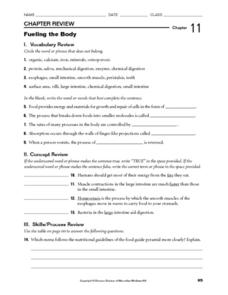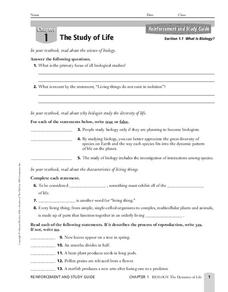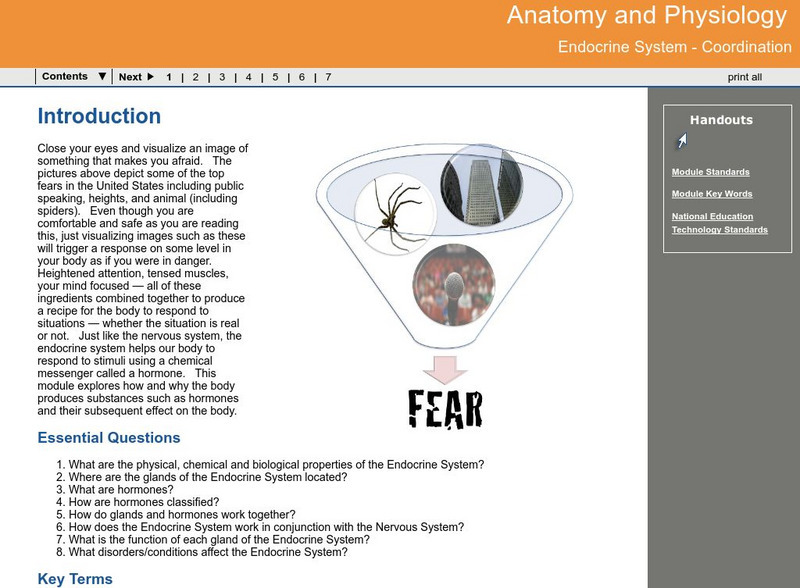Curated OER
Antiseptic Nature of Plants
Students investigate the concepts of homeostasis, competition, pathogens, and antiseptics. They conduct an experiment that compares the antiseptic properties of native plants by growing bacteria on agar plates containing plant extracts,...
Curated OER
Medic!
Learners navigate and analyze information about the presentation of a disease during a class discussion. They document and share their analysis of information in a class discussion in order to describe a variety of disease origins.
Curated OER
Human Body Regulation
Students investigate how the human body self-regulates to maintain a stable internal environment despite changes in the external environment -- a process called homeostasis.
Curated OER
Homeostasis and the Human Body
Don't expect much from this presentation. It contains five slides in addition to the title. The first describes homeostasis, the second states that it operates at all levels and lists the biological hierarchy, the third gives three...
Curated OER
Regulation - Human Nervous and Endocrine Systems
Students explore homeostasis within the nervous and endocrine system with this Smart Board activity. For this biology lesson plan, students will fill in the know and want to know sections of a KWL chart as a class using a...
Study Stack
Biology Crossword Puzzle
In this online interactive biology crossword puzzle worksheet, students use the 7 clues to find the appropriate answers to complete the word puzzle.
Curated OER
What is Biology?
In this biology worksheet, students review the characteristics of life and the scientific method. This worksheet has 19 fill in the blank, 6 matching, and 2 short answer questions.
Curated OER
The Urinary System
For this urinary system worksheet, students review the role the kidneys and nephrons play in the formation of urine. Students order the steps of the filtration of blood. This worksheet has 3 short answer and 10 fill in the blank questions.
Curated OER
Fueling the Body
In this nutrition learning exercise, students review the organs and enzymes that are part of the digestive system. Then students review the food pyramid by comparing two menus. This learning exercise has 9 fill in the blank, 4 true or...
Curated OER
What is Biology?
In this science of biology instructional activity, students will review the concepts relating to biology including the characteristics of living things, the process of reproduction, adaptations, and evolution. This instructional activity...
Curated OER
The Plasma Membrane
In this plasma membrane learning exercise, students will explore how cells are able to maintain homeostasis and the function of the plasma membrane. This learning exercise has 6 fill in the blank and 7 true or false questions.
Curated OER
Digestion and Nutrition
In this homeostasis worksheet, students will read about how the food we eat helps our body to maintain homeostasis. Students will complete 1 short answer question and 3 true or false questions.
Curated OER
Homeostasis and the Plasma Membrane
In this homeostasis and the plasma membrane worksheet, learners complete a flow chart and 5 questions related to homeostasis and the plasma membrane. They complete a flow chart that illustrates the plasma membrane and cellular transport....
Curated OER
Homeostasis and the Plasma Membrane
In this homeostasis and plasma membrane worksheet, students use the given diagram to answer 5 questions at the bottom of the sheet. They determine what the outside layers of a plasma membrane are made up of. Then, students explain how...
Curated OER
Homeostasis and the Plasma Membrane
In this homeostasis and plasma membrane worksheet, learners complete 4 different questions related to the diagram shown at the top of the sheet. They draw an arrow across the plasma membrane in the diagram to show which way water...
Curated OER
Organ System Interactions
Eighth graders who have studied all of the organ systems now discover how they all are related and work together in the human body. They discuss a variety of situations in which more than one system plays a part. They identify the...
Curated OER
Immunization
learners study contents and origin of vaccines. They should understand the relationship of the vaccine to primary and secondary immune responses of the body. They work in pairs and share the responsibility of writing responses to...
Curated OER
Ecology: Factors Influencing Animal Populations
Learners assess the factors affecting animal populations. Working in groups they define specific vocabulary terms and complete several activities from "Project Wild."
Curated OER
Introduction to Biology
In this biology worksheet, 9th graders identify and locate various vocabulary terms related to an introduction to the study of biology. There are 19 biology terms located in the word search.
Curated OER
Feedback and Flowcharts
Sixth graders explain what a negative feedback system is and they distinguish it from a positive feedback system. They describe examples of how negative feedback is used in both nature and technology. , Students define homeostasis, and...
Concord Consortium
Concord Consortium: Stem Resources: Diffusion, Osmosis, and Active Transport
Have you ever wondered how important gases enter and leave cells? Take an up close tour of a pore in a cell membrane. Then explore diffusion, osmosis, and active transport through this collection of interactive models.
Georgia Department of Education
Ga Virtual Learning: Biology: Cells
A complete, interactive course where students analyze the nature of the relationships between structures and functions in living cells.
Georgia Department of Education
Ga Virtual Learning: Anatomy and Physiology: Endocrine System
Through informational text, video clips, practice problems, and external assignments, students discover the structure and function of the endocrine system of the human body.
PBS
Pbs Learning Media: Function of Fever
Fevers are a sign of infection, but they may also be part of the cure. This drawing illustrates Matthew Kluger's lizard study, which supports the notion that fever can be beneficial.

























